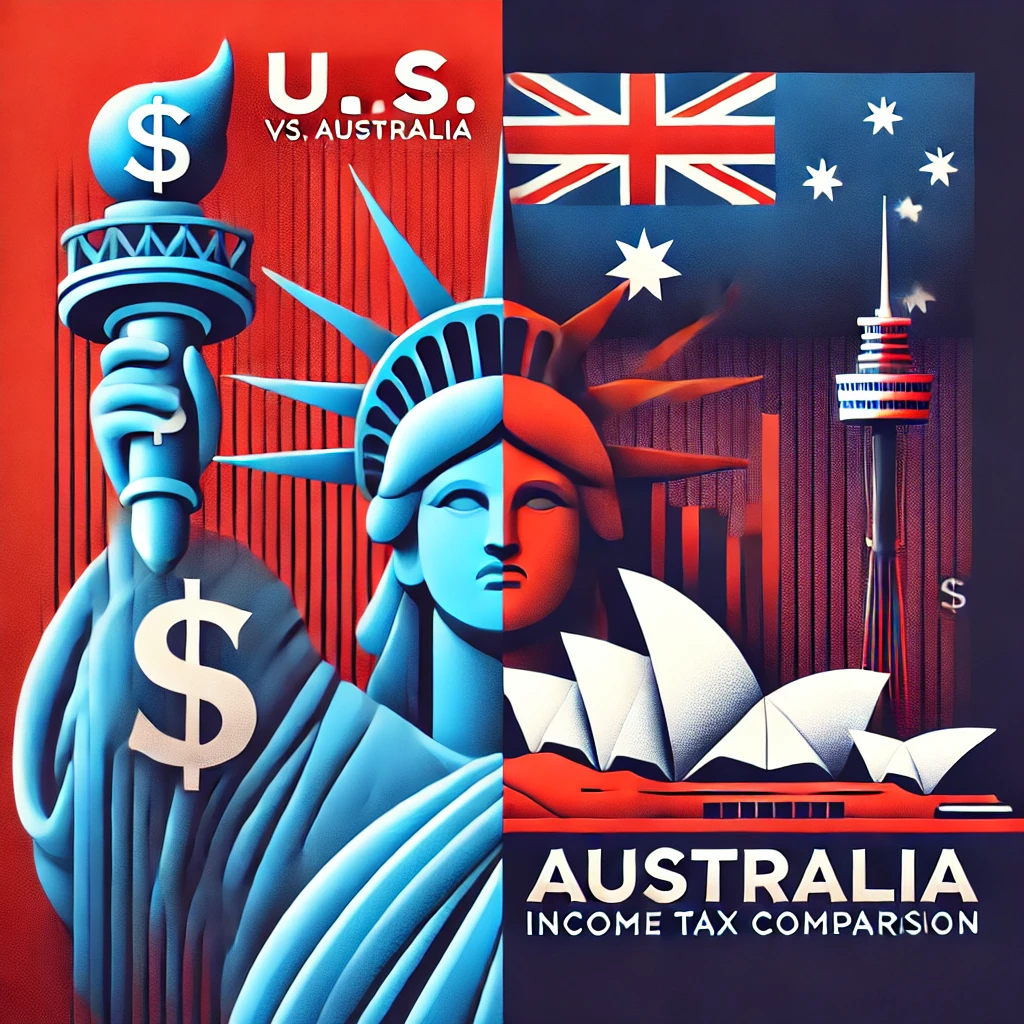When comparing personal income tax rates between the United States and Australia, it’s essential to consider not only the tax brackets but also the differences in how each country structures its tax system. This post will explore these differences, provide a side-by-side comparison of the income tax brackets in both countries, and adjust for currency exchange rates to offer a clearer picture for those earning in either USD or AUD. We will also discuss state taxes in the U.S., Australian superannuation, and U.S. Social Security.
Tax Systems Overview
United States
- Federal Tax: The U.S. employs a progressive tax system, where higher income is taxed at higher rates. Income tax is collected by the federal government, and additional state or local taxes may apply depending on where you live.
- State Taxes: In addition to federal taxes, most U.S. states impose their own income tax, which varies widely. Some states, like California and New York, have relatively high state income taxes, while others, such as Florida and Texas, have no state income tax at all. This adds another layer of complexity to the U.S. tax system, as residents in different states can experience vastly different tax burdens.
- Tax Deductions and Credits: Taxpayers can lower their taxable income through various deductions and credits, such as the standard deduction, itemized deductions, and tax credits like the Child Tax Credit.
Australia
- Federal Tax: Australia also uses a progressive tax system. However, unlike the U.S., there is no separate state income tax. Instead, the Australian Taxation Office (ATO) handles all income tax collections.
- Medicare Levy: An additional 2% Medicare levy is typically applied to taxable income to fund the public health system. Higher income earners without private health insurance may pay an additional Medicare levy surcharge.
- Tax Offsets: Australia provides various tax offsets that can reduce the tax payable, including the Low and Middle Income Tax Offset (LMITO).
Income Tax Brackets Comparison (2024)
To provide a meaningful comparison, we will convert the Australian tax brackets into USD using the current exchange rate, which is approximately 1 AUD = 0.64 USD (as of August 2024). This conversion allows us to compare the tax burden relative to income in each country.
United States Federal Income Tax Brackets (2024)
| Tax Rate | Income Bracket (Single) | Income Bracket (Married Filing Jointly) |
|---|---|---|
| 10% | Up to $11,000 | Up to $22,000 |
| 12% | $11,001 – $44,725 | $22,001 – $89,450 |
| 22% | $44,726 – $95,375 | $89,451 – $190,750 |
| 24% | $95,376 – $182,100 | $190,751 – $364,200 |
| 32% | $182,101 – $231,250 | $364,201 – $462,500 |
| 35% | $231,251 – $578,125 | $462,501 – $693,750 |
| 37% | Over $578,125 | Over $693,750 |
For more detailed information, you can visit the IRS official website.
Australian Income Tax Brackets (2024) Converted to USD
| Tax Rate | Income Bracket (AUD) | Income Bracket (USD Equivalent) |
|---|---|---|
| 0% | Up to AUD 18,200 | Up to USD 11,648 |
| 19% | AUD 18,201 – 45,000 | USD 11,649 – 28,800 |
| 32.5% | AUD 45,001 – 120,000 | USD 28,801 – 76,800 |
| 37% | AUD 120,001 – 180,000 | USD 76,801 – 115,200 |
| 45% | Over AUD 180,000 | Over USD 115,201 |
For more details, check out the Australian Taxation Office.
Adjusting for Currency Exchange Rates
To better understand these numbers, consider how much income falls into each bracket after converting Australian dollars to U.S. dollars.
- Australia’s tax-free threshold starts at AUD 18,200, which converts to roughly USD 11,648. In the U.S., income below USD 11,000 is taxed at 10%.
- Middle-income earners in Australia, earning between AUD 45,001 and AUD 120,000 (USD 28,801 – 76,800), are taxed at a rate of 32.5%. In the U.S., income in this range falls mostly under the 22% and 24% brackets.
- High-income earners above AUD 180,000 (USD 115,201) are taxed at 45% in Australia, while the highest U.S. federal rate is 37% for income over USD 578,125.
Taxation Example for Comparable Income Levels
Let’s consider a scenario where an individual earns the equivalent of USD 100,000 in both countries.
United States
Federal Tax Liability: This income would fall into the 24% bracket. Assuming standard deductions, the tax owed would be calculated progressively across the brackets.
Australia
Tax Liability: This income falls under the 32.5% tax bracket. However, it’s important to consider that only the portion above the lower brackets is taxed at 32.5%, with the remainder taxed at the respective lower rates.
Australian Superannuation vs. U.S. Social Security
Beyond income tax, retirement contributions are another crucial factor when comparing the financial obligations of living in the United States versus Australia.
Australian Superannuation
- Mandatory Contributions: In Australia, employers must contribute a minimum of 11% (as of 2024) of an employee’s earnings to a superannuation fund. This system is designed to help Australians save for retirement. Employees can also make additional voluntary contributions.
- Accessing Superannuation: Funds are generally locked until retirement age (currently 60 for most Australians), ensuring that individuals have savings for their retirement years.
- Taxation: Superannuation contributions are generally taxed at a lower rate of 15%, making it a tax-effective way to save for retirement.
For more information, you can visit the Australian Government’s Superannuation page.
U.S. Social Security
- Payroll Taxes: In the U.S., Social Security is funded through payroll taxes, with 6.2% of an employee’s earnings (up to a certain limit) being deducted from their paycheck, and an additional 6.2% contributed by the employer. This adds up to a total of 12.4%.
- Benefits: Social Security provides retirement benefits based on the individual’s lifetime earnings and the age at which they begin collecting benefits. Full retirement age varies, but it is generally around 66 to 67 years old.
- Taxation: Unlike superannuation, there is no separate tax on contributions, but benefits received in retirement may be subject to income tax depending on total income.
For more details, you can check the Social Security Administration’s website.
Case Study: Comparing Tax and Take-Home Pay at Various Salary Levels
To provide a clearer understanding of how income tax and contributions affect take-home pay in the United States and Australia, we have prepared a summary table for different salary levels. The table includes total tax (federal/state tax for the U.S. and income tax/Medicare levy for Australia), mandatory retirement contributions (Superannuation for Australia and Social Security for the U.S.), and the resulting take-home pay.
Assumptions:
- U.S.: State tax rates are considered average for states with income tax (approximately 5%), and the Social Security tax rate is 6.2%. The standard deduction is applied.
- Australia: The Medicare levy is included at 2% of taxable income, and superannuation contributions are at 11%.
Summary Table
| Country | Salary (USD) | Total Tax (USD) | Retirement Contributions (USD) | Take-Home Pay (USD) |
|---|---|---|---|---|
| United States | $50,000 | $8,078 | $3,100 | $38,822 |
| Australia | $50,000 | $5,376 | $5,500 | $39,124 |
| United States | $100,000 | $22,140 | $6,200 | $71,660 |
| Australia | $100,000 | $22,075 | $11,000 | $66,925 |
| United States | $150,000 | $38,585 | $9,300 | $102,115 |
| Australia | $150,000 | $38,550 | $16,500 | $94,950 |
| United States | $200,000 | $55,965 | $12,400 | $131,635 |
| Australia | $200,000 | $56,075 | $22,000 | $121,925 |
| United States | $250,000 | $73,700 | $15,500 | $160,800 |
| Australia | $250,000 | $73,600 | $27,500 | $148,900 |
| United States | $300,000 | $91,650 | $18,600 | $189,750 |
| Australia | $300,000 | $91,150 | $33,000 | $175,850 |
Analysis of the Case Study
- Total Tax: At the $50,000 income level, Australians pay slightly less tax but have higher retirement contributions compared to Americans. At $100,000, the tax burden is nearly identical in both countries, but take-home pay is slightly lower in Australia due to higher retirement contributions. For higher income levels, Australians face a significantly higher tax rate and superannuation contributions compared to Americans, resulting in a lower take-home pay.
- Retirement Contributions: Australia’s mandatory superannuation contributions are significantly higher than the U.S. Social Security contributions, especially at higher income levels, affecting take-home pay. While Australians save more for retirement through mandatory contributions, Americans have more take-home pay but might need to rely more on personal savings and investments for retirement.
- Take-Home Pay: Americans generally have a higher take-home pay across all income levels due to lower tax rates and mandatory contributions compared to Australia.
This summary table provides a clear comparison of how income tax, mandatory contributions, and take-home pay differ between the United States and Australia. Individuals considering living or working in either country should carefully consider these financial impacts, particularly at higher income levels where the differences become more pronounced.
This detailed comparison helps provide a comprehensive view of the financial landscape in both countries, offering essential insights for anyone looking to understand their potential tax obligations and take-home pay in the U.S. versus Australia.




